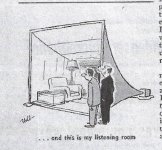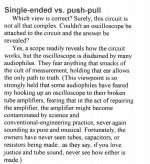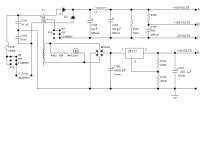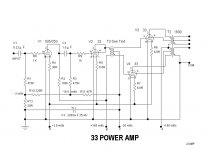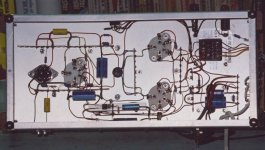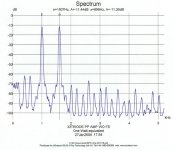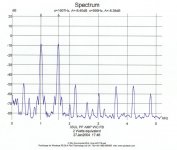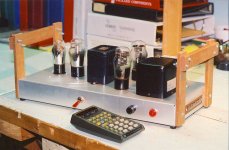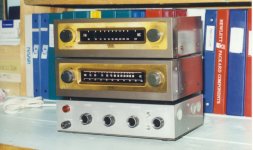If the diode-bias sounds better than filament bias with a resistor, then we have an interesting data-point, but it is not immediately obvious why it should be. With filament bias, a resistor of about 30Ω would be a starting point.
30Ω in the cathode has almost zero effect on the gm of the 01A (800µA/V to about 780µA/V), so maybe we have something like a excess current-noise in the resistor - which is construction dependent. And as I know you have found sound quality differences among various resistors, this is quite likely.
The other possibility is that the little extra non-linear contribution to the bias, from the diode V vs. I - maybe it adds a little liveliness to the sound. You mentioned that a bit of fatigue was evident from longer sessions of listening (a known downside of such distortion), so maybe some measurement of the difference is worth the effort.
Grid bias should be better still, especially in terms of low distortion, but some don't like the grid capacitor. The Russian teflons sound fine to me in this position, but that's a matter of taste....
30Ω in the cathode has almost zero effect on the gm of the 01A (800µA/V to about 780µA/V), so maybe we have something like a excess current-noise in the resistor - which is construction dependent. And as I know you have found sound quality differences among various resistors, this is quite likely.
The other possibility is that the little extra non-linear contribution to the bias, from the diode V vs. I - maybe it adds a little liveliness to the sound. You mentioned that a bit of fatigue was evident from longer sessions of listening (a known downside of such distortion), so maybe some measurement of the difference is worth the effort.
Grid bias should be better still, especially in terms of low distortion, but some don't like the grid capacitor. The Russian teflons sound fine to me in this position, but that's a matter of taste....
We see many subjective observations here. Has anyone taken the time to look with a scope, how did a sine wave look after going thru? Better still, do the obvious, THD & IMD tests. Discover what is causing the changes in sound.
Good new & used test equipment is very affordable now. And a great investment for anyone serious about pursuing the mysteries of electronics.
In ancient times many of us built our own TE. From a kit. Or from the ground up, no kit at all! It worked.
Good new & used test equipment is very affordable now. And a great investment for anyone serious about pursuing the mysteries of electronics.
In ancient times many of us built our own TE. From a kit. Or from the ground up, no kit at all! It worked.
Attachments
I asked earlier why fixed (grid) bias was not used so as to eliminate everything in the cathode circuit. You could use a TVC or input transformer and bias through the secondary, not needing a cap then and possible adding a little gain or the TVC functionality in one go.
Personally I would look into finding an optimal resistor for filament bias.
Has anyone tried to check if what you are hearing is not an issue caused by the filament current source, which is pumping current through the cathode resistor? In a regular cathode bias, the current is only a few mA vs the 0.25-1A that is going through there now with filament bias. So there may be two sources at play for this effect in sound that are compounding.
Personally I would look into finding an optimal resistor for filament bias.
Has anyone tried to check if what you are hearing is not an issue caused by the filament current source, which is pumping current through the cathode resistor? In a regular cathode bias, the current is only a few mA vs the 0.25-1A that is going through there now with filament bias. So there may be two sources at play for this effect in sound that are compounding.
We have been auditioning many resistors. My favourite, displacing the otherwise good vitreous enamel ones, is a military wire wound one from Russia in a silver colour.
Filament supply is always an issue, as you say. I always use choke input for that reason - it's smoother.
Filament supply is always an issue, as you say. I always use choke input for that reason - it's smoother.
That's simplistic and outdated. There's nothing at all wrong with measuring and nothing for 'audiophiles' to be afraid of. On the contrary, there's a lot of great modern measuring equipment about which can help in all sorts of ways. As long as it's used together with listening. But surely we all know this?
Here is the info on a DH amp I built a while ago. Notice lots of performance data.
This amp has none of the warts I see others having problems with in this thread. It is not a rat's nest of wire in a wooden box, something that invites trouble in.
But the 1B5 is microphonic!
This amp has none of the warts I see others having problems with in this thread. It is not a rat's nest of wire in a wooden box, something that invites trouble in.
But the 1B5 is microphonic!
Attachments
Grid bias should be better still, especially in terms of low distortion, but some don't like the grid capacitor. The Russian teflons sound fine to me in this position, but that's a matter of taste....
Rod could you post the schematic for 26 or a link?
TIA
Felipe
We have been auditioning many resistors. My favourite, displacing the otherwise good vitreous enamel ones, is a military wire wound one from Russia in a silver colour.
Filament supply is always an issue, as you say. I always use choke input for that reason - it's smoother.
Andy do you remember the reference of russian wire wound silver colour?
TIA
Felipe
I'm fairly certain he is referring to the 'S5' type, looks like 'C5' on the resistors themselves.
51 Ohm 10W Russian Precision Wire Wound Resistors 18 pcs | eBay
Cheers,
Gable
51 Ohm 10W Russian Precision Wire Wound Resistors 18 pcs | eBay
Cheers,
Gable
We have been auditioning many resistors. My favourite, displacing the otherwise good vitreous enamel ones, is a military wire wound one from Russia in a silver colour.
How does one audition a resistor? What properties do we test for?
Well, we all listen in different ways so I can only speak for myself. Resistors, or any parts in fact, always get auditioned in the same way. I was a working professional musician for 15 years, classical, orchestral, jazz, small groups etc. I have an excellent memory and the timbre of each instrument is stored in my memory. I listen for just 2 things - timbre and transparency. First it's a question of what you can and can't hear in a complex mix, and then it's a question of how authentic the timbre of each acoustic instruments or voice is. So typically I'll use a heavily scored orchestral excerpt, for which I use Ravel Feria (Cleveland/Boulez) plus an excerpt from an opera with a few different voices plus chorus, for which I use Janacek's Cunning Little Vixen. A large number of different timbres, and some very low level detail. That's it.
I imagine you are referring to electrical properties, and if I had the measuring equipment and the training in using it I'd love to answer that question. But my training is in the music itself - 3 years conservatoire and 15 years of live gigs. After my career as a musician I've been a psychologist specialising in musicians for 30 years. Since psychology is heavily into measurement and data analysis I'm the last person that's going to belittle measurement of any kind.
I imagine you are referring to electrical properties, and if I had the measuring equipment and the training in using it I'd love to answer that question. But my training is in the music itself - 3 years conservatoire and 15 years of live gigs. After my career as a musician I've been a psychologist specialising in musicians for 30 years. Since psychology is heavily into measurement and data analysis I'm the last person that's going to belittle measurement of any kind.
Last edited:
Here is the info on a DH amp I built a while ago. Notice lots of performance data.
This amp has none of the warts I see others having problems with in this thread. It is not a rat's nest of wire in a wooden box, something that invites trouble in.
But the 1B5 is microphonic!
thanks for the dht info, i didnt knew that neat one
I'm fairly certain he is referring to the 'S5' type, looks like 'C5' on the resistors themselves.
51 Ohm 10W Russian Precision Wire Wound Resistors 18 pcs | eBay
Cheers,
Gable
Yes - those are the ones.
Many thanks guys.
OK Andy, thankyou for the a description of that method. And you are correct, I'm looking at the problem from an engineers point of view. I'm very results driven, I like to see things get done in a timely & professional way.Well, we all listen in different ways so I can only speak for myself. Resistors, or any parts in fact, always get auditioned in the same way. I was a working professional musician for 15 years, classical, orchestral, jazz, small groups etc. I have an excellent memory and the timbre of each instrument is stored in my memory. I listen for just 2 things - timbre and transparency. First it's a question of what you can and can't hear in a complex mix, and then it's a question of how authentic the timbre of each acoustic instruments or voice is. So typically I'll use a heavily scored orchestral excerpt, for which I use Ravel Feria (Cleveland/Boulez) plus an excerpt from an opera with a few different voices plus chorus, for which I use Janacek's Cunning Little Vixen. A large number of different timbres, and some very low level detail. That's it.
I imagine you are referring to electrical properties, and if I had the measuring equipment and the training in using it I'd love to answer that question. But my training is in the music itself - 3 years conservatoire and 15 years of live gigs. After my career as a musician I've been a psychologist specialising in musicians for 30 years. Since psychology is heavily into measurement and data analysis I'm the last person that's going to belittle measurement of any kind.
I've been building amps & other electronics for more than 70 yrs. But never my day job. I will be 86 in a couple of wks. But other than failures for one reason or another I've never experienced any serious problems with the linear components, Ls, Cs & Rs.
The distortion from the tubes & transistors has always dominated, so long as care was taken in selection of the other parts. Output transformers & electrolytics can cause problems as well.
I did take the time to consult my Funk & Wagnalls Dictionary in regard to definition of 'euphony', a term used by many in these threads. From that I believe quite a bit of the sound you & others analyze by ear can be measured. With existing equipment.
I like Classical & Jazz. But Rock too. The Rolling Stones, Pink Floyd, ZZ Top, Phil Collins & on & on. I have a large collection of vinyl & CDs. My dayly driver is a Sansui AU717/TU717 combo. And in the workshop, Eico AM & FM tuners. Going thru my home grown complete 3W amp with phono front end, all in a Hammond chassis. That one built in 1968.
Attachments
Correlation of measurement to listening impression are rather esoteric and scarce. The effort requires sensitive equipments that used to be insanely expensive and at least one sensitive listener.OK Andy, thankyou for the a description of that method. And you are correct, I'm looking at the problem from an engineers point of view. I'm very results driven, I like to see things get done in a timely & professional way. ...
As an example, XRK971 in AKSA's Lender Preamp with 40Vpp Output did find a measured difference of 0805 smt thick film (first mistakenly referred to as metal film and later corrected to thick film) and carbon composition exclusively on feedback position at -90 to -100dB, however no correlation to sonic presentation.
Spread thinly here in Diyaudio forum, I noted findings of correlation of frequency response, distortion spectra and phase of second harmonic to sonic presentation by notables such as Nelson Pass (and Joe Sammut), John Curl (and Bob Crump), highly respected teams, and the late Charles Hansen who had the very rare combination of both exotic equipments and sensitive hearing. Other findings in Diyaudio I value is the coordinated effort of Alejandro Moglia, Andy Evans and Rod Coleman.
However, dbt result from panel of experienced listener is needed for the findings to be accepted by the AES (in which nobody cares to finance), hence the scarcity of official publication.
For those not familiar with John Broskie, here is the address of his website- GlassWare Software's Home Page
A cornucopia of info on vacuum tube amplifiers, etc.
PIM, Passive Intermodulation Distortion is of great interest in the communications buz. That would be cell phones, TV & so on. Occurs in connectors, cabling, etc, often in the transmit & receive signals to the antenna
Boonton & others have had test equipment on the market for about 10 yrs. What it shows is the capability is available now for development of audio measurement equipment that might ID some of the things that musicians report hearing.
Boonton was one of the product lines I flogged during the last 5 yrs of my career. Very nice stuff, very leading edge.
Lots of info covering PIM on the web.
A cornucopia of info on vacuum tube amplifiers, etc.
PIM, Passive Intermodulation Distortion is of great interest in the communications buz. That would be cell phones, TV & so on. Occurs in connectors, cabling, etc, often in the transmit & receive signals to the antenna
Boonton & others have had test equipment on the market for about 10 yrs. What it shows is the capability is available now for development of audio measurement equipment that might ID some of the things that musicians report hearing.
Boonton was one of the product lines I flogged during the last 5 yrs of my career. Very nice stuff, very leading edge.
Lots of info covering PIM on the web.
- Home
- Amplifiers
- Tubes / Valves
- 01A question
